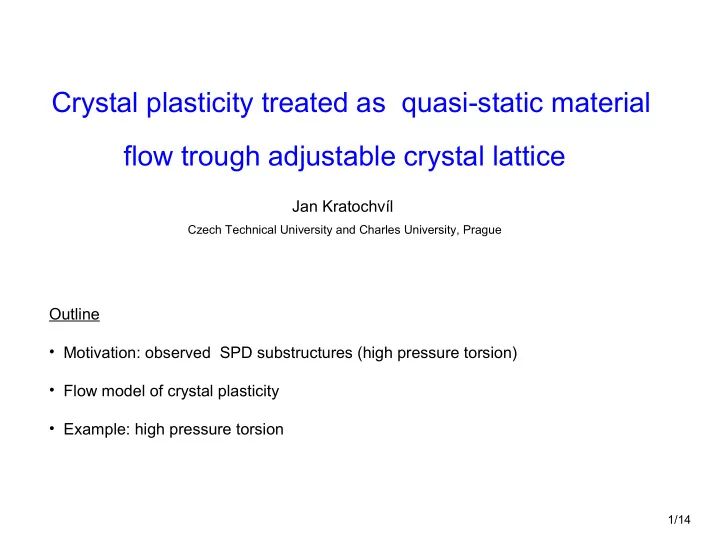

Crystal plasticity treated as quasi-static material flow trough adjustable crystal lattice Jan Kratochvíl Czech Technical University and Charles University, Prague Outline • Motivation: observed SPD substructures (high pressure torsion) • Flow model of crystal plasticity • Example: high pressure torsion 1/14
Motivation high pressure torsion • After an initial adjustment to a tool, specimens twisted under high axial compression do not change their shape and they withstand unlimited amount of plastic deformation • An initial non-steady material flow (up to strain >~ 20) is followed by a steady flow (saturation) where no further work hardening and structural changes are observed • The observations excluded grain boundary sliding as the main mechanism in explored HPT; the deformation was achieved by intergranular glide • Strain can be defined approximately as simple shear Austrian school: Habesberger, Pippan, Schafler, Stüve, Vorhauer, Wetscher, Zehetbauer 2/14
Motivation • preferred alignment of structural elements in radial direction inclined with respect to the torsion axis the alignment is changing with reverse of twist no alignment is observed in axial direction HPT copper: Hebesberger et al.: Acta Mat. (2004) axial viewpoint radial viewpoint 3/14
Motivation Motivated by severe plastic deformation experiments it seems that crystalline materials at yield behave as a special kind of incompressible, anisotropic, highly viscous fluids. Crystal plasticity can be interpreted as: material flow though adjustable crystal lattice space analogously as a riverbed adjusts to a water flow . HPT copper: Hebesberger et al.: Acta Mat. (2004) The material flow through the crystal lattice has been regarded by Asaro as crystal plasticity "basic tenet“ Advances in Applied Mechanics, 1983. 4/14
Flow model of crystal plasticity crystal plasticity framework: misoriented cells (subgrains): rate dependent (rigid-viscous-plastic) principal variables of the model: velocity slip rates rotation of lattice stress yield stresses governing equations: scheme of corresponding lattice space: kinematics: • flow rule • GND density dynamics: • stress equilibrium • dissipation inequality constitutive relations: • yield condition • hardening law 5/14
Flow model of crystal plasticity Kinematics • flow rule: rate of lattice adjustment material flow material stretching: evolution of lattice adjustment: • GND density: seen in micrographs 6/14
Flow model of crystal plasticity Dynamics • stress equilibrium: • resolved shear stress: • dissipation inequality: 7/14
Flow model of crystal plasticity Constitutive relations • yield condition: • hardening law: local hardening non-local hardening (close range dislocation interaction) Grama et al Acta Materialia 2003, Kratochvil et al Physical Review 2007 Boundary conditions: • periodic • surface layer Kuroda & Tvergaard Int. J. Mechanics and Physics of Solids 2008 8/14
Example: high pressure torsion radial direction ~ simple shear r θ γ = h axial direction ~ plastic strain gradient θ γ ∇ γ = = ρ ρ = b , G G h rb − ρ = 13 − 14 2 10 10 m G 9/14
Example: high pressure torsion double slip rigid-plastic model v velocity field α lattice rotation ( , κ κ 1 ) ( 2 ) slip rates rate of lattice rotation material flow 2 ∑ ∇ = − + κ ⊗ 1 ( i ) ( i ) ( i ) v R R s m = i 1 in components: ∂ ∂ ∂ ∂ v ∂ ∂ v v v v v α − φ − − y α − φ − α + φ + + y α + φ 2 x cos 2 ( ) ( x ) sin 2 ( ) 2 x cos 2 ( ) ( x ) sin 2 ( ) ∂ ∂ ∂ ∂ ∂ ∂ x y x x y x κ ( 1 ) = − κ ( 2 ) = φ φ sin 4 sin 4 ∂ ∂ ∂ v v v α + α + φ α − φ − y α + φ α − φ x sin 2 x cos( ) cos( ) sin( ) sin( ) ∂ ∂ ∂ x y x α = − φ cos 2 Kratochvíl, Kružík and Sedláček: Acta Materialia (2009) 10/14
1. rotation of slip systems: homogeneous solution Kratochvíl, Kružík and Sedláček: Acta Materialia (2009) rate of rotation ∂ v • • • = L x xy ∂ y • • double slip activity steady state single slip • steady state single slip is reached asymptotically (saturation) ! homogenous states are unstable ! 11/14
2. fragmentation = spontaneous structuralization formation and reconstruction of structural elements (subgrains) Kratochvíl, Kružík and Sedláček: Rev.Adv.Mater.Sci. (2010) Scheme of misoriented fragmented structural elements . fragmentation of crystal or polycrystalline grains into a pattern of structural elements (misoriented cells) is a result of a trend to reduce energetically costly multislip. orientation of the pattern follows the orientation of the slip systems rotation of the slip systems causes a permanent subgrains reconstruction 12/14
Example: high pressure torsion cell size: Kratochvíl, Kružík and Sedláček: Phys. Rev. B (2007) shear modulus G hardening h G/h = 100 16 − 2 dislocation density in boundaries ρ = m 10 R ~ 1μm width of non-equilibrium boundaries δ = 10 nm 13/14
Summary: interpretation of HPT observations Kratochvíl, Kružík and Sedláček: Acta Materialia (2009), Rev.Adv.Mater.Sci. (2010) key assumption: glide is carried by a double slip along rotating slip systems modeling: material flow through adjustable crystal lattice observations model preferred alignment structural misorientation “ 3D meanders” saturation ? size 14/14
Recommend
More recommend